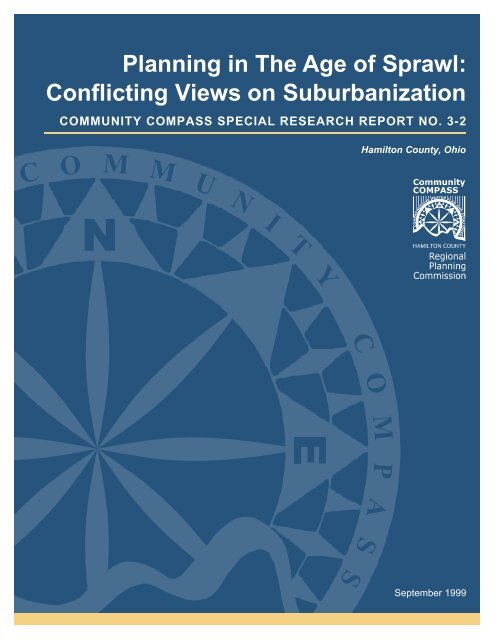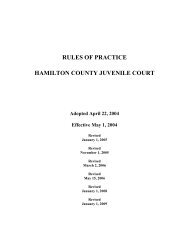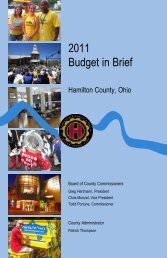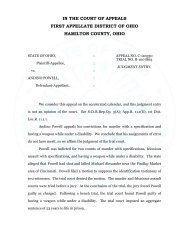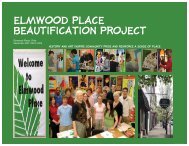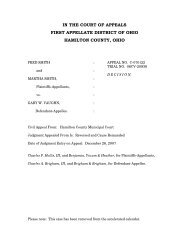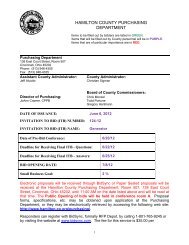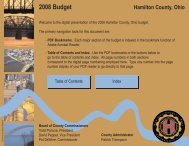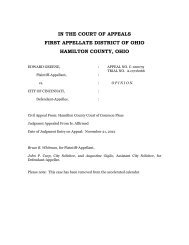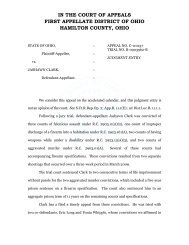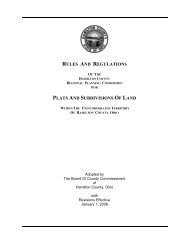Planning in The Age of Sprawl - Hamilton County, Ohio
Planning in The Age of Sprawl - Hamilton County, Ohio
Planning in The Age of Sprawl - Hamilton County, Ohio
You also want an ePaper? Increase the reach of your titles
YUMPU automatically turns print PDFs into web optimized ePapers that Google loves.
<strong>Plann<strong>in</strong>g</strong><strong>in</strong><strong>The</strong><strong>Age</strong> <strong>of</strong> <strong>Sprawl</strong>:<br />
Conflict<strong>in</strong>g Viewson Suburbanization<br />
COMMUNITY COMPASS SPECIAL RESEARCH REPORT NO. 3-2<br />
<strong>Hamilton</strong> <strong>County</strong>, <strong>Ohio</strong><br />
September 1999
ABSTRACT<br />
Title:<br />
<strong>Plann<strong>in</strong>g</strong> <strong>in</strong> the <strong>Age</strong> <strong>of</strong> <strong>Sprawl</strong>:<br />
Conflict<strong>in</strong>g Views on Suburbanization.<br />
(Work<strong>in</strong>g Paper)<br />
Community COMPASS<br />
Research Report No. 99-001<br />
Subject:<br />
Conflict<strong>in</strong>g views on<br />
suburbanization and sprawl.<br />
Date: September 1999<br />
<strong>The</strong> <strong>Plann<strong>in</strong>g</strong> Partnership is the long-range<br />
collaborative plann<strong>in</strong>g and coord<strong>in</strong>at<strong>in</strong>g committee <strong>of</strong><br />
the HCRPC. Its mission is to br<strong>in</strong>g together public,<br />
private and civic sector organizations engaged <strong>in</strong><br />
community plann<strong>in</strong>g <strong>in</strong> <strong>Hamilton</strong> <strong>County</strong> so that<br />
mutual goals related to physical, economic and social<br />
issues can be planned for comprehensively and<br />
achieved collaboratively.<br />
Community COMPASS is the Comprehensive<br />
Master Plan and Strategies for <strong>Hamilton</strong> <strong>County</strong>,<br />
<strong>Ohio</strong>. It is a major <strong>in</strong>itiative <strong>of</strong> the <strong>Plann<strong>in</strong>g</strong><br />
Partnership.<br />
RPC Staff<br />
Ron Miller, AICP, Executive Director<br />
Mark Abell<br />
Karen Ambrosius<br />
Carol<strong>in</strong>e Andrews Statkus, AICP<br />
Jim Bowen<br />
Bob Eaton<br />
Tim Horsley, Ph.D.<br />
Steve Johns, AICP<br />
Lorra<strong>in</strong>e Jordan<br />
Todd K<strong>in</strong>skey, AICP<br />
Catal<strong>in</strong>a Landivar-Simon, AICP<br />
Teresa Lawson<br />
Christ<strong>in</strong>e Nolan<br />
Lance Schultz, AICP<br />
Steve Sievers, AICP<br />
Paul Smiley<br />
Jay Spr<strong>in</strong>ger<br />
Project Team<br />
Ron Miller, AICP, Author<br />
Paul Smiley & Jay Spr<strong>in</strong>ger, Cover Art<br />
Lorra<strong>in</strong>e Jordan & Paul Smiley, GIS Maps<br />
Source <strong>of</strong><br />
Copies:<br />
Synopsis:<br />
Notes:<br />
<strong>Hamilton</strong> <strong>County</strong><br />
Regional <strong>Plann<strong>in</strong>g</strong> Commission<br />
Room 807<br />
<strong>County</strong> Adm<strong>in</strong>istration Build<strong>in</strong>g<br />
138 East Court Street<br />
C<strong>in</strong>c<strong>in</strong>nati, OH 45202<br />
513-946-4500 (Phone)<br />
513-946-4475 (Fax)<br />
<strong>in</strong>fo@rpc.hamilton-co.org<br />
www.hamilton-co.org/hcrpc<br />
This report presents a summary <strong>of</strong><br />
divergent views on suburbanization<br />
and sprawl as well as a scan <strong>of</strong> the<br />
range <strong>of</strong> op<strong>in</strong>ions regard<strong>in</strong>g what<br />
should be done. <strong>The</strong> unique <strong>in</strong>fluence<br />
<strong>of</strong> rugged topography on growth<br />
patterns and sprawl are identified to<br />
facilitate community discussion <strong>of</strong><br />
important local issues related to<br />
obscured consequences <strong>of</strong> sprawl <strong>in</strong><br />
<strong>Hamilton</strong> <strong>County</strong>’s hillside<br />
environment.<br />
<strong>The</strong> report is part <strong>of</strong> a series <strong>of</strong><br />
research reports provid<strong>in</strong>g technical<br />
<strong>in</strong>formation to support Community<br />
COMPASS (Comprehensive Master<br />
Plan and Strategies for <strong>Hamilton</strong><br />
<strong>County</strong>, <strong>Ohio</strong>).<br />
<strong>The</strong> content <strong>of</strong> this paper does not<br />
necessarily reflect the <strong>of</strong>ficial views or<br />
policies <strong>of</strong> the <strong>Hamilton</strong> <strong>County</strong><br />
Regional <strong>Plann<strong>in</strong>g</strong> Commission.<br />
About the Cover:<br />
<strong>The</strong> three <strong>Hamilton</strong> <strong>County</strong> maps<br />
show the development pattern <strong>of</strong><br />
residential dwell<strong>in</strong>gs constructed on<br />
or before 1930, 1960 and 1998<br />
respectively.
PLANNING IN THE AGE OF SPRAWL<br />
CONFLICTING VIEWS ON SUBURBANIZATION<br />
TABLE OF CONTENTS<br />
INTRODUCTION 1<br />
ABOUT THIS REPORT 1<br />
A RANGE OF DEFINITIONS 2<br />
A RANGE OF SUBURBAN VIEWS 3<br />
A RANGE OF CONSEQUENCES 6<br />
A RANGE OF CAUSES 7<br />
A RANGE OF ADVICE 9<br />
HAMILTON COUNTY’S SPATIAL FRAMEWORK 11<br />
Notes 13<br />
Bibliography 14<br />
“We are us<strong>in</strong>g land plann<strong>in</strong>g strategies which are<br />
40 years old and no longer relevant or affordable<br />
to today’s culture. We are still build<strong>in</strong>g World<br />
War II suburbs as if families were large and had<br />
only one breadw<strong>in</strong>ner, as if jobs were all<br />
downtown, as if land and energy were endless and<br />
as if another lane on the freeway would end traffic<br />
congestion. It is time to overhaul the American<br />
dream… We must move...from segregated sprawl<br />
to place more like traditional American towns.”—<br />
Peter Calthorpe and Henry Richmond, Chang<strong>in</strong>g<br />
America<br />
“<strong>Sprawl</strong> has gotten a bad rap. It has become the<br />
all-purpose catchword for the rape <strong>of</strong> the<br />
environment by unscrupulous builders. But<br />
<strong>Sprawl</strong> is also an expression <strong>of</strong> upward mobility.<br />
An unprecedented 67 percent <strong>of</strong> Americans now<br />
own their own homes. <strong>Sprawl</strong> is part <strong>of</strong> the price<br />
we’re pay<strong>in</strong>g for creat<strong>in</strong>g the world’s first mass<br />
upper-middle class.”—New Democrat
This report may be freely copied, duplicated or extracted with the appropriate<br />
citations and acknowledgements as shown below, or <strong>in</strong> conformance with the<br />
conventions <strong>of</strong> the MLA Style Manual.<br />
Suggested Citation:<br />
Miller, Ronald P., <strong>Plann<strong>in</strong>g</strong> <strong>in</strong> the <strong>Age</strong> <strong>of</strong> <strong>Sprawl</strong> – a Pr<strong>of</strong>usion <strong>of</strong> Perspectives,<br />
Comprehensive Plan Research Report Number 99-001, <strong>Hamilton</strong> <strong>County</strong> Regional<br />
<strong>Plann<strong>in</strong>g</strong> Commission, C<strong>in</strong>c<strong>in</strong>nati, <strong>Ohio</strong>, September, 1999.
INTRODUCTION<br />
<strong>Plann<strong>in</strong>g</strong> <strong>in</strong> the <strong>Age</strong> <strong>of</strong> <strong>Sprawl</strong><br />
CONFLICTING VIEWS ON SUBURBANIZATION<br />
Even before urban sprawl became a presidential campaign issue by Vice President Al Gore,<br />
there was more written about it than anyone could possibly read. Now there’s more. In just<br />
a few seconds my search on the web <strong>of</strong>fered me 17,234 sites to read about “urban sprawl”!<br />
In review<strong>in</strong>g even a small part <strong>of</strong> the plethora <strong>of</strong> new literature on sprawl, one must conclude<br />
that a healthy pr<strong>of</strong>usion <strong>of</strong> perspectives exists and that the literature is highly subjective.<br />
<strong>The</strong> range <strong>of</strong> values related to sprawl or suburbanization, and the diversity <strong>of</strong> pr<strong>of</strong>essional<br />
op<strong>in</strong>ion regard<strong>in</strong>g suburban plann<strong>in</strong>g and related metropolitan impacts, is a central concern<br />
to the <strong>Hamilton</strong> <strong>County</strong> Regional <strong>Plann<strong>in</strong>g</strong> Commission and to the greater C<strong>in</strong>c<strong>in</strong>nati<br />
metropolitan region as we <strong>in</strong>itiate studies to update the <strong>County</strong>’s comprehensive plan. This<br />
plan will necessarily engage a cont<strong>in</strong>u<strong>in</strong>g discussion on alternative views <strong>of</strong> the future<br />
related to divergent economic orientations—long term versus short term and collective<br />
versus <strong>in</strong>dividual. Myers and Kitsuse succ<strong>in</strong>ctly def<strong>in</strong>e the problem <strong>in</strong> <strong>The</strong> Debate Over<br />
Future Density <strong>of</strong> Development: “Economic models that support the wisdom <strong>of</strong> sprawl are<br />
<strong>in</strong>herently short-term frameworks which assume that efficient, short-run decisions made at<br />
the level <strong>of</strong> the <strong>in</strong>dividual add up to a good long-range future.” 1<br />
<strong>The</strong> plann<strong>in</strong>g dialogue related to <strong>Hamilton</strong> <strong>County</strong>’s comprehensive plan will basically focus<br />
on how we want to live <strong>in</strong> the future--<strong>in</strong> the context <strong>of</strong> an ever <strong>in</strong>creas<strong>in</strong>g list <strong>of</strong> compet<strong>in</strong>g<br />
objectives and priorities – employment, environment, hous<strong>in</strong>g, transportation, education,<br />
aesthetics, social diversity, economic diversity, etc. How can we accommodate people<br />
throughout their life cycles How can we accommodate new social trends affect<strong>in</strong>g the<br />
family unit and the work unit How much growth should be encouraged Where and when<br />
should it occur What type <strong>of</strong> growth should be encouraged<br />
ABOUT THIS REPORT<br />
What follows is a somewhat perfunctory look at conflict<strong>in</strong>g views on many <strong>of</strong> these issues as<br />
they perta<strong>in</strong> to suburbanization and sprawl as well as a scan <strong>of</strong> the range <strong>of</strong> op<strong>in</strong>ions<br />
regard<strong>in</strong>g what should be done. <strong>The</strong> unique <strong>in</strong>fluence <strong>of</strong> <strong>Hamilton</strong> <strong>County</strong>’s rugged<br />
topography on growth patterns and sprawl are identified to facilitate community discussion<br />
<strong>of</strong> important local issues related to obscured consequences <strong>of</strong> sprawl <strong>in</strong> our hillside<br />
environment. <strong>The</strong> rich diversity <strong>of</strong> op<strong>in</strong>ions identified below will hopefully generate needed<br />
dialogue among local stakeholders and potential plann<strong>in</strong>g partners as we attempt to articulate<br />
a collective vision for <strong>Hamilton</strong> <strong>County</strong>.<br />
A RANGE OF DEFINITIONS<br />
First, what is this phenomenon called sprawl Proponents <strong>of</strong> conventional suburban growth<br />
<strong>of</strong>ten speak <strong>in</strong>stead <strong>in</strong> terms <strong>of</strong> suburbanization, outward growth and economic development.<br />
ugly chaos <strong>of</strong> “laissez faire urbanization”. Even the American Heritage Dictionary def<strong>in</strong>es<br />
HCRPC<br />
PLANNING IN THE AGE OF SPRAWL<br />
1
However, one person’s utopia is another’s sprawl. Opponents to sprawl describe it as the<br />
ugly chaos <strong>of</strong> “laissez faire urbanization”. Even the American Heritage Dictionary def<strong>in</strong>es<br />
sprawl as “haphazard growth or extension outward, especially that result<strong>in</strong>g from new<br />
hous<strong>in</strong>g”. Much <strong>of</strong> the literature talks about sprawl, urban sprawl and suburban sprawl<br />
without ever def<strong>in</strong><strong>in</strong>g it—as if a common def<strong>in</strong>ition exists. However, differ<strong>in</strong>g def<strong>in</strong>itions <strong>of</strong><br />
sprawl abound:<br />
• <strong>Sprawl</strong> is the cont<strong>in</strong>ual use <strong>of</strong> more land than is necessary to accomplish a given<br />
development goal.<br />
• <strong>Sprawl</strong> is the consumption <strong>of</strong> resources and land <strong>in</strong> excess <strong>of</strong> what is needed to create a<br />
comfortable, livable and functional city.<br />
• <strong>Sprawl</strong> is “leapfrog” development patterns, conta<strong>in</strong><strong>in</strong>g commercial strips and large<br />
expanses <strong>of</strong> separate land uses accessible only by car, and lack<strong>in</strong>g functional open space.<br />
• <strong>Sprawl</strong> is the rapid spread <strong>of</strong> fragmented, low-density, automobile-dependent<br />
development on the fr<strong>in</strong>ges <strong>of</strong> cities.<br />
• <strong>Sprawl</strong> is a pattern <strong>of</strong> strip development and spread-out low-density development <strong>in</strong> the<br />
countryside that leads to a gradual decl<strong>in</strong>e <strong>in</strong> community life and values, and the erosion<br />
<strong>of</strong> the economic base <strong>in</strong> cities and villages.<br />
• <strong>Sprawl</strong> is discontiguous and low-density development patterns that gobble up farmland<br />
and open space.<br />
• <strong>Sprawl</strong> is low-density development beyond the edge <strong>of</strong> service and employment, which<br />
separates where people live from where they shop, work, recreate, and educate - thus<br />
requir<strong>in</strong>g cars to move between zones.<br />
• <strong>Sprawl</strong> is a fifty-year-long experiment <strong>in</strong> wretched excess that endorses the disposability<br />
<strong>of</strong> the built environment—an <strong>in</strong>satiable consumption apparatus, dra<strong>in</strong><strong>in</strong>g life from cities,<br />
devour<strong>in</strong>g open space, siphon<strong>in</strong>g precious time <strong>of</strong>f to automobile travel, separat<strong>in</strong>g<br />
people from one another, and leav<strong>in</strong>g a trail <strong>of</strong> washed-up neighborhoods and shopp<strong>in</strong>g<br />
centers <strong>in</strong> its wake. (adapted from remarks <strong>of</strong> Robert Davis, chairman <strong>of</strong> the Congress<br />
for New Urbanism)<br />
• <strong>Sprawl</strong> is low-density, auto-dependent development that rapidly spreads on the fr<strong>in</strong>ges <strong>of</strong><br />
exist<strong>in</strong>g communities, <strong>of</strong>ten consum<strong>in</strong>g agricultural and environmentally sensitive lands.<br />
• <strong>Sprawl</strong> is random development characterized by poor accessibility among related land<br />
uses such as hous<strong>in</strong>g, jobs and services.<br />
• <strong>Sprawl</strong> is the massive oversupply <strong>of</strong> developmental <strong>in</strong>frastructure <strong>in</strong> restrictively zoned<br />
communities creat<strong>in</strong>g social and economic polarization with<strong>in</strong> the region as well as land<br />
use patterns that are particularly low density, economically <strong>in</strong>efficient and<br />
environmentally dangerous.<br />
<strong>The</strong> last def<strong>in</strong>ition <strong>of</strong>fers particular local relevance, s<strong>in</strong>ce it alludes to development patterns<br />
<strong>in</strong> this region dur<strong>in</strong>g the last half century as well as the potentially harmful effects that are <strong>of</strong><br />
<strong>in</strong>creas<strong>in</strong>g concern with<strong>in</strong> <strong>Hamilton</strong> <strong>County</strong>.<br />
A RANGE OF SUBURBAN VIEWS<br />
In the communities <strong>in</strong> <strong>Hamilton</strong> <strong>County</strong> as well as our region there is a great diversity <strong>of</strong><br />
op<strong>in</strong>ion about the desirability <strong>of</strong> suburban (a.k.a. sprawl) development. Not that anyone<br />
2<br />
HCRPC<br />
PLANNING IN THE AGE OF SPRAWL
admits to be<strong>in</strong>g pro-sprawl—it’s not a nice word! I once was told that sprawl is what a slob<br />
with a big belly and a beer can is do<strong>in</strong>g when he is draped across the s<strong>of</strong>a watch<strong>in</strong>g<br />
wrestl<strong>in</strong>g--<strong>in</strong>ferr<strong>in</strong>g that anyth<strong>in</strong>g characterized as sprawl<strong>in</strong>g cannot be good. However,<br />
residents <strong>of</strong> suburban neighborhoods--many oblivious to the fact that “<strong>Sprawl</strong>-R-Us”--are<br />
great champions <strong>of</strong> suburban liv<strong>in</strong>g. Indeed, the suburban neighborhood—with or without<br />
the label <strong>of</strong> sprawl--is exactly what most suburban residents want. That’s why they live<br />
there! And, that’s been made quite clear to me at many public meet<strong>in</strong>gs dur<strong>in</strong>g discussions<br />
about community values and goals. Many surveys support the claim that low density<br />
settlement is the overwhelm<strong>in</strong>g choice for residential liv<strong>in</strong>g.<br />
Current land use and development practices are defended by many. Supporters <strong>of</strong><br />
conventional suburban development (i.e., the predom<strong>in</strong>ant suburban character built s<strong>in</strong>ce<br />
1950) deem the use <strong>of</strong> the term sprawl to be pejorative. <strong>The</strong>y prefer terms describ<strong>in</strong>g<br />
development such as suburban, dispersed, decentralized, discont<strong>in</strong>uous and multi-centered,<br />
multi-nodal or polycentric. Proponents <strong>of</strong> the status-quo note that conventional patterns <strong>of</strong><br />
development are necessary to economic prosperity, that open space is meant to be enjoyed at<br />
home--not after a long drive outside the growth boundary. <strong>The</strong>y are proponents <strong>of</strong> an<br />
abundance <strong>of</strong> privatized open space <strong>in</strong> the form <strong>of</strong> front and back yards. In their view, the<br />
net effects <strong>of</strong> conventional development patterns are overwhelm<strong>in</strong>gly positive, contribut<strong>in</strong>g<br />
to economic growth and to the social objective <strong>of</strong> widespread homeownership—exactly as<br />
envisioned by the 1939 World’s Fair where the most popular exhibition was General<br />
Motor’s “World <strong>of</strong> Tomorrow”, featur<strong>in</strong>g an enormous model <strong>of</strong> an auto-utopia called “City<br />
<strong>of</strong> the Future”. Another social benefit <strong>of</strong>ten cited as a positive result <strong>of</strong> the current suburban<br />
development strategy is “filter<strong>in</strong>g down” or mak<strong>in</strong>g <strong>in</strong>ner city hous<strong>in</strong>g available to lower<strong>in</strong>come<br />
people as it is vacated by others mov<strong>in</strong>g up and out. Indeed, n<strong>in</strong>eteenth- and early<br />
twentieth-century reformers, who viewed the congestion <strong>of</strong> the city as a pr<strong>of</strong>ound evil would<br />
have looked at today’s decentralization or “suburban sprawl” (GM’s “World <strong>of</strong> Tomorrow”<br />
that we live <strong>in</strong> today) as an improvement too good to be imag<strong>in</strong>ed. 1<br />
<strong>The</strong> Wells Fargo Bank, <strong>in</strong> Preserv<strong>in</strong>g the American Dream, defends the current development<br />
patterns say<strong>in</strong>g that current suburbia is simply <strong>in</strong> the early stages <strong>of</strong> development. Over time<br />
these suburbs will transform <strong>in</strong>to higher density areas support<strong>in</strong>g developed commercial<br />
economies as well as jobs—a process <strong>of</strong> dispersal followed by later <strong>in</strong>fill. <strong>The</strong> theory<br />
resembles the natural growth and evolution <strong>of</strong> forests (succession <strong>of</strong> weed, grass, and forest<br />
communities) where early stages are essential but not as attractive or useful as a mature<br />
forest. In their view, the utopic visions <strong>of</strong> the 1940’s and 1950’s have been achieved—Why<br />
fix what isn’t broke <strong>The</strong>y assert that the traffic consequences <strong>of</strong> suburban development are<br />
benign s<strong>in</strong>ce commutes shorten as jobs move to the suburbs to be closer to the labor force.<br />
In their view, consumer preference for low-density, s<strong>in</strong>gle family homes is so entrenched<br />
that any alternative to the current suburban spatial order will never have anyth<strong>in</strong>g wider than<br />
a boutique appeal. 1<br />
<strong>The</strong> Wells Fargo view is reiterated <strong>in</strong> Jack Nasar’s <strong>The</strong> Evaluative Image <strong>of</strong> the City. He<br />
expla<strong>in</strong>s that design pr<strong>of</strong>essionals don’t share the values <strong>of</strong> the public and don’t deliver those<br />
values <strong>in</strong> designs and plan: “For more than 60 years, planners and designers have attacked<br />
the suburban landscape. Yet the public around the world cont<strong>in</strong>ues to evaluate it favorably<br />
as the ideal.”<br />
HCRPC<br />
PLANNING IN THE AGE OF SPRAWL<br />
3
On a similar note, <strong>in</strong> Design<strong>in</strong>g the City, Towards a More Susta<strong>in</strong>able Urban Form,<br />
Hildebrand Frey identifies that what we care to admire as a tourist (nostalgic and sometimes<br />
quirky) is not necessarily what we would accept as a place to live. She writes that compact<br />
development concepts contradict the pr<strong>of</strong>ound fondness for suburban and semi-rural liv<strong>in</strong>g.<br />
She also expla<strong>in</strong>s that the smart growth and compact city <strong>in</strong>itiatives are certa<strong>in</strong>ly <strong>in</strong>fluenced<br />
by the fact that many historic towns and cities have densely developed cores which are seen<br />
as ideal places to live and work (mostly by those com<strong>in</strong>g to visit these places for a short<br />
time, not necessarily by their <strong>in</strong>habitants). Visual preference surveys <strong>of</strong>ten reveal similar<br />
conclusions—that residents like to visit or look at qua<strong>in</strong>t and historic places but generally<br />
choose not to live there.<br />
In expla<strong>in</strong><strong>in</strong>g this pr<strong>of</strong>ound fondness for suburban rather than urban liv<strong>in</strong>g David Rusk, <strong>in</strong><br />
Cities Without Suburbs, says “Suburban sprawl is a barga<strong>in</strong> to suburban residents (and<br />
therefore thriv<strong>in</strong>g and considered as the desired development pattern) due to cheap home<br />
mortgages, dream houses, affordable private cars, federally subsidized highways and<br />
susta<strong>in</strong>ed economic growth, the romance <strong>of</strong> the “the frontier” — <strong>The</strong> American Dream —<br />
promoted to the middle class s<strong>in</strong>ce 1950 by ‘Wash<strong>in</strong>gton, Wall Street, Detroit, Hollywood,<br />
and Madison Avenue’”.<br />
Today Rusk might add Silicon Valley to his list <strong>of</strong> icons that <strong>in</strong>fluence middle class<br />
preferences. Many suburban communities today are not just bedroom communities, but<br />
what Jon Teaford <strong>of</strong> Purdue University calls “post-suburbia”: economically and culturally<br />
self-sufficient areas that are near traditional core cities but largely <strong>in</strong>sulated from them.<br />
Many employers—especially high tech firms—look for the post-suburbia features: safe,<br />
clean, easy to get around and new. <strong>The</strong>se features spell economic competitiveness and<br />
survival by act<strong>in</strong>g as magnets to attract scarce highly skilled employees.<br />
On the opposite side <strong>of</strong> the Wells Fargo ideology is Howard Kunstler. In “Home from<br />
Nowhere”, he decries not only the social, environmental and economic cost <strong>of</strong> sprawl but<br />
also condemns its very appearance. “We drive up and down the gruesome, tragic suburban<br />
boulevards <strong>of</strong> commerce, and we’re overwhelmed at the fantastic, awesome, stupefy<strong>in</strong>g<br />
ugl<strong>in</strong>ess <strong>of</strong> absolutely everyth<strong>in</strong>g <strong>in</strong> sight...as though the whole th<strong>in</strong>g had been designed by<br />
some diabolical force bent on mak<strong>in</strong>g human be<strong>in</strong>gs miserable.” Kunstler believes that a<br />
variety <strong>of</strong> forces—both economic (gasol<strong>in</strong>e shortages and prices, the high cost <strong>of</strong><br />
ma<strong>in</strong>ta<strong>in</strong><strong>in</strong>g a vast highway <strong>in</strong>frastructure) and social (a grow<strong>in</strong>g feel<strong>in</strong>g <strong>of</strong> lonel<strong>in</strong>ess and<br />
lack <strong>of</strong> community) – will soon br<strong>in</strong>g an end to what he calls “the automobile utopia.” But,<br />
even Kunstler acknowledges that “right now it would seem that Americans do not want to<br />
change their behavior”.<br />
Of course, people cannot want someth<strong>in</strong>g they are not even aware <strong>of</strong>. And they can’t be<br />
expected to want to solve a problem that is not even recognized as a problem. “So little <strong>of</strong><br />
our historic landscape rema<strong>in</strong>s that it is difficult to appreciate our present aesthetic<br />
deprivation, hav<strong>in</strong>g few opportunities for comparison” argues John Miller <strong>in</strong> Egotopia,<br />
Narcissism and the New American Landscape. He po<strong>in</strong>ts out that the New American<br />
4<br />
HCRPC<br />
PLANNING IN THE AGE OF SPRAWL
Landscape is no longer about public and communal values, but rather a place “dedicated to<br />
uncompromis<strong>in</strong>g notions <strong>of</strong> utility”.<br />
Others clarify that perhaps behavior change will not have to be forced—that a great latent<br />
demand for an improved lifestyle <strong>in</strong> alternative liv<strong>in</strong>g environments already exists. All that<br />
is necessary is to provide the alternative liv<strong>in</strong>g environments and people will choose such<br />
environments. “Of course, the issue is not about forc<strong>in</strong>g people … to give up their suburban<br />
cul-de-sac or three cars. <strong>The</strong> issue is about giv<strong>in</strong>g others an alternative so this selfdestructive<br />
national madness can be conta<strong>in</strong>ed. Suburbs are not for everyone”, writes<br />
Roberta Gratz <strong>in</strong> Cities, Back from the Edge. In discuss<strong>in</strong>g the oxymoron <strong>of</strong> the suburban<br />
city she expla<strong>in</strong>s that “hybrid suburban urbanism” --striv<strong>in</strong>g for the best <strong>of</strong> two contradictory<br />
worlds--is unachievable. Gratz po<strong>in</strong>ts out that suburbs cannot replace cities and they cannot<br />
shake their irrevocable dependency on cities – that the suburb is still a sub-urb, a dependent<br />
<strong>of</strong>fshoot <strong>of</strong> a more complex urban center.<br />
Some writers see the old suburban dream as be<strong>in</strong>g <strong>in</strong>creas<strong>in</strong>gly out <strong>of</strong> sync with today’s<br />
culture. Peter Calthorpe <strong>in</strong> <strong>The</strong> Next American Metropolis, Ecology, Community and the<br />
American Dream, states that “we cont<strong>in</strong>ue to build post-World War II suburbs as if families<br />
were large and had only one breadw<strong>in</strong>ner, as if the jobs were all downtown, as if land and<br />
energy were endless, and as if another lane on the freeway would end traffic congestion.”<br />
Historical circumstance has changed. <strong>The</strong> urban environment is no longer the slum and<br />
coal-belch<strong>in</strong>g <strong>in</strong>dustrial environment that drove people from the city <strong>in</strong> the 19 th and early<br />
20 th centuries. Nor are we prepar<strong>in</strong>g for pent-up hous<strong>in</strong>g demand as required <strong>in</strong> the post-<br />
World War II years. Values have changed and we have now superceded the 1939 World’s<br />
Fair vision. Calthorpe notes that post WWII development forces—the privatization <strong>of</strong> life<br />
and specialization <strong>of</strong> place—results <strong>in</strong> both the city and suburb be<strong>in</strong>g locked <strong>in</strong> a mutually<br />
negat<strong>in</strong>g evolution toward loss <strong>of</strong> community, human scale, and nature. <strong>The</strong>se patterns <strong>of</strong><br />
growth have created congestion, pollution, isolation and urban dis<strong>in</strong>vestments. He describes<br />
a world doomed to be dom<strong>in</strong>ated by specialization, segregation, and lack <strong>of</strong> scale if trends<br />
are not changed.<br />
“While some have proposed a rigorous return to traditional city forms and an almost pre<strong>in</strong>dustrial<br />
culture as a counterpo<strong>in</strong>t, others have praised this placeless evolution <strong>of</strong> the<br />
suburban megalopolis. <strong>The</strong>y claim it is the <strong>in</strong>evitable and desirable expression <strong>of</strong> our new<br />
technologies and hyper-<strong>in</strong>dividualized culture,” accord<strong>in</strong>g to Calthorpe.<br />
Many other counter-arguments support the absence <strong>of</strong> need for any change. Proponents <strong>of</strong><br />
conventional suburban development argue that suburban and exurban growth should be<br />
accommodated rather than restricted, and directed with market-oriented measures rather than<br />
regulation --<strong>The</strong> <strong>Sprawl</strong><strong>in</strong>g <strong>of</strong> America: In Defense <strong>of</strong> the Dynamic City by Samuel Staley.<br />
<strong>The</strong> pro-growth values are <strong>of</strong>ten supported by ample statistics <strong>in</strong>dicat<strong>in</strong>g we have no<br />
farmland crisis and no need for compact development. <strong>The</strong> “crisis” is simply fabricated by<br />
farmland def<strong>in</strong>itions, and therefore related statistics, be<strong>in</strong>g mis<strong>in</strong>terpreted. <strong>The</strong>y expla<strong>in</strong> that<br />
“farmland” <strong>of</strong>ten means that land could produce crops if farmed or perhaps that land is<br />
zoned as agriculture. “Cropland”, by contrast, is agricultural land on which food is actually<br />
produced. So, while anti-sprawl activists may accurately claim that <strong>Ohio</strong> is los<strong>in</strong>g 10 acres<br />
<strong>of</strong> farmland per hour, growth proponents accurately claim that the amount <strong>of</strong> land on which<br />
HCRPC<br />
PLANNING IN THE AGE OF SPRAWL<br />
5
crops are grown is ris<strong>in</strong>g each year. Growth proponents cite that the rate <strong>of</strong> farmland loss is<br />
actually much lower than it used to be – i.e., the national rate was four times greater dur<strong>in</strong>g<br />
the 1970’s accord<strong>in</strong>g to urban economist Samuel Staley. Growth proponents also note that<br />
over the last half-century, more open space has been turned <strong>in</strong>to parks and rural wildlife<br />
preserves than has been turned <strong>in</strong>to suburbs. Also, farmers have become so efficient on the<br />
rema<strong>in</strong><strong>in</strong>g farmland that they’re grow<strong>in</strong>g twice as much food as <strong>in</strong> 1950, and could easily<br />
grow much more if there were a market for it. So, compact growth or any other alternative<br />
form <strong>of</strong> suburban development is simply not needed accord<strong>in</strong>g to most supporters <strong>of</strong> the<br />
status-quo.<br />
<strong>The</strong> defense <strong>of</strong> suburban development cont<strong>in</strong>ues <strong>in</strong> the Wells Fargo report, Preserv<strong>in</strong>g the<br />
American Dream. It dismisses concern over loss <strong>of</strong> agricultural land by show<strong>in</strong>g that the<br />
entire population <strong>of</strong> the U.S. could be arranged <strong>in</strong> households <strong>of</strong> four people at typical<br />
“suburban sprawl” densities and still only use 3 percent <strong>of</strong> the total land area <strong>of</strong> the<br />
contiguous U.S. 1<br />
A RANGE OF CONSEQUENCES<br />
<strong>The</strong> Sierra Club’s <strong>The</strong> Dark Side <strong>of</strong> the American Dream: <strong>The</strong> Costs and Consequences <strong>of</strong><br />
<strong>Sprawl</strong> documents consequences <strong>of</strong> sprawl that reach way beyond the issue <strong>of</strong> farmland loss.<br />
<strong>The</strong>y also identify: traffic congestion; longer commutes that steal time from family and<br />
work; worsen<strong>in</strong>g air and water pollution; loss <strong>of</strong> open fields, forests and wetlands; <strong>in</strong>creased<br />
flood<strong>in</strong>g; erosion <strong>of</strong> the central city tax base; raised taxes to pay for services – police, fire,<br />
schools, roads, water, and sewer; destruction <strong>of</strong> central city commerce; and concentration <strong>of</strong><br />
poverty <strong>in</strong> urban centers. <strong>The</strong> concentration and separation <strong>of</strong> poverty and wealth also<br />
results <strong>in</strong> suburban employers be<strong>in</strong>g <strong>in</strong>creas<strong>in</strong>gly unable to fill lower pay<strong>in</strong>g jobs due to lack<br />
<strong>of</strong> affordable transportation l<strong>in</strong>ks between low skilled workers and job vacancies located <strong>in</strong><br />
wealthy suburban enclaves.<br />
<strong>The</strong> Bank <strong>of</strong> America’s report, Beyond <strong>Sprawl</strong>, identifies another laundry list <strong>of</strong> negative<br />
effects: higher costs <strong>of</strong> hous<strong>in</strong>g, <strong>in</strong>creas<strong>in</strong>g road congestion, excessive travel, dw<strong>in</strong>dl<strong>in</strong>g<br />
land availability, poorer public services, loss <strong>of</strong> agricultural land, poor air and water quality,<br />
decl<strong>in</strong>e <strong>of</strong> central city neighborhoods and older suburbs, deteriorated quality <strong>of</strong> life,<br />
excessive cost to ma<strong>in</strong>ta<strong>in</strong> <strong>in</strong>frastructure, abandoned and underutilized <strong>in</strong>vestments <strong>in</strong> older<br />
neighborhoods. 1<br />
Richard Moe describes sprawl’s <strong>in</strong>fluence on migration and related negative impacts on<br />
older areas. “<strong>The</strong> cont<strong>in</strong>ually sprawl<strong>in</strong>g metropolis encourages outmigration from the<br />
metropolitan core and first suburbs. Migrations, whether across oceans or municipal<br />
boundaries, are the outcome <strong>of</strong> factors that push people away from one place and pull them<br />
to another. Pushed out by dropp<strong>in</strong>g property values, decl<strong>in</strong><strong>in</strong>g schools, meaner streets, and<br />
ris<strong>in</strong>g taxes residents <strong>of</strong> decl<strong>in</strong><strong>in</strong>g neighborhoods are pulled elsewhere by the opposite. It is<br />
this migratory pattern, played out <strong>in</strong> neighborhood after neighborhood, that pushes a city<br />
past the po<strong>in</strong>t <strong>of</strong> no return” -- Chang<strong>in</strong>g Places - Rebuild<strong>in</strong>g Community <strong>in</strong> the <strong>Age</strong> <strong>of</strong><br />
<strong>Sprawl</strong> by Richard Moe.<br />
Myron Orfield clearly reveals the creep<strong>in</strong>g movement <strong>of</strong> sprawl’s effects <strong>in</strong> his book,<br />
6<br />
HCRPC<br />
PLANNING IN THE AGE OF SPRAWL
Metropolitics. “Contrary to popular belief, socioeconomic <strong>in</strong>stability does not stop neatly at<br />
central-city borders. As it crosses <strong>in</strong>to <strong>in</strong>ner suburbs, especially <strong>in</strong>to suburbs that were once<br />
blue-collar and middle-class neighborhoods, it accelerates and <strong>in</strong>tensifies. Central cities<br />
have a fiscal, governmental, and social <strong>in</strong>frastructure to slow these powerful trends. Lack<strong>in</strong>g<br />
the central city's central bus<strong>in</strong>ess district tax base, welfare <strong>in</strong>frastructure and network <strong>of</strong><br />
organized political activity, <strong>in</strong>ner suburbs <strong>of</strong>ten decl<strong>in</strong>e far more rapidly.” Older suburbs <strong>in</strong><br />
urban counties, also known as “first suburbs” and “grayfields” are mature, land-locked and<br />
built-out. <strong>The</strong>y can quickly spiral <strong>in</strong>to decl<strong>in</strong>e due to erosion <strong>of</strong> population, hous<strong>in</strong>g stock,<br />
jobs and tax base. <strong>The</strong> decl<strong>in</strong>e is <strong>of</strong>ten rooted <strong>in</strong> state policies that encourage “greenfields”<br />
development (build<strong>in</strong>g on vacant undeveloped land) and do not provide equal opportunities<br />
to established communities with “grayfield” redevelopment opportunities. Avoid<strong>in</strong>g rapid<br />
decl<strong>in</strong>e <strong>of</strong> older suburbs <strong>in</strong> urban counties requires partnerships that promote public policies<br />
for ma<strong>in</strong>ta<strong>in</strong><strong>in</strong>g the vitality <strong>of</strong> our established communities rather than creat<strong>in</strong>g disposable<br />
communities. This partnership <strong>of</strong> “first suburbs” will be a critical element <strong>in</strong> any strategy to<br />
reverse the decl<strong>in</strong>e <strong>of</strong> older communities <strong>in</strong> <strong>Hamilton</strong> <strong>County</strong>.<br />
A RANGE OF CAUSES<br />
<strong>The</strong> literature also conta<strong>in</strong>s various explanations regard<strong>in</strong>g the causes <strong>of</strong> sprawl. <strong>Sprawl</strong> is<br />
no doubt the outcome <strong>of</strong> two great American liberation movements: personal transportation<br />
and a spread <strong>of</strong> your own—largely born <strong>in</strong> the 1950’s and go<strong>in</strong>g strong today. Both are<br />
outgrowths <strong>of</strong> federal policies and the availability <strong>of</strong> money after World War II. <strong>The</strong><br />
National Defense Highway Act <strong>of</strong> 1956 created the <strong>in</strong>terstate highway system for quick<br />
<strong>in</strong>ter-city and <strong>in</strong>ter-coastal mobility and to deliberately disperse <strong>in</strong>dustry <strong>in</strong>to the<br />
countryside – theoretically mak<strong>in</strong>g it less vulnerable to nuclear attack. <strong>The</strong> Federal Hous<strong>in</strong>g<br />
Adm<strong>in</strong>istration created the other suburbanization driver – the guaranteed mortgage. This<br />
f<strong>in</strong>ancial <strong>in</strong>strument built the American suburbs with low down-payment, long term, fixed<br />
<strong>in</strong>terest mortgages, essentially riskless to banks. <strong>The</strong>se behemoth federal policies cont<strong>in</strong>ue<br />
to drive the suburban character and overpower local plann<strong>in</strong>g <strong>in</strong>itiatives that may attempt to<br />
change the conventional suburban development pattern. Accord<strong>in</strong>g to Roberta Gratz,<br />
“<strong>Sprawl</strong> cont<strong>in</strong>uation makes sense only with recognition that to tame it, stop it, unravel it,<br />
and dramatically alter a 50-year, entrenched national development pattern, an entire<br />
<strong>in</strong>terrelated network <strong>of</strong> rules must be fundamentally changed. Inertia is the enemy <strong>of</strong><br />
change”.<br />
New levels <strong>of</strong> <strong>in</strong>ertia are expected to emanate from technology. Digital electronics will<br />
cont<strong>in</strong>ually make it possible for cities to become more and more dispersed and polarized<br />
s<strong>in</strong>ce <strong>of</strong>fice work will travel rather than <strong>of</strong>fice workers. <strong>The</strong> irrelevance <strong>of</strong> geography will<br />
drive the trend toward rural and decentralized workplaces -- High Technology and Low-<br />
Income Communities: Prospects for the Positive Use <strong>of</strong> Advanced Information Technology,<br />
edited by Donald Schon.<br />
We are rem<strong>in</strong>ded <strong>of</strong> the importance <strong>of</strong> American values dur<strong>in</strong>g the past two centuries by<br />
Richard Moe <strong>in</strong> Chang<strong>in</strong>g Places: Rebuild<strong>in</strong>g Community <strong>in</strong> the <strong>Age</strong> <strong>of</strong> <strong>Sprawl</strong>. He writes<br />
that Americans desire newness and change at the expense <strong>of</strong> context and stability. “Escape<br />
and start over” is a long-held American tenet. <strong>The</strong> 21 st Century will no doubt br<strong>in</strong>g new<br />
technological forces that will cont<strong>in</strong>ue decentralization trends.<br />
HCRPC<br />
PLANNING IN THE AGE OF SPRAWL<br />
7
Given such root causes <strong>of</strong> sprawl, its well established foundation, cultural forces, as well as<br />
current state and federal growth policies, it should not be a surprise to anyone that the<br />
problems associated with sprawl are not likely to be reversed simply by local or county<br />
plann<strong>in</strong>g <strong>in</strong>itiatives – especially <strong>in</strong> the strong home-rule environment <strong>of</strong> <strong>Ohio</strong>. Only a few<br />
North American metropolitan areas (e.g., Portland, Vancouver and Toronto) have made any<br />
substantial progress <strong>in</strong> sprawl wars. And then, only after decades <strong>of</strong> work and billions <strong>in</strong><br />
public <strong>in</strong>vestment required by the mandates <strong>of</strong> state and regional government. This is not<br />
very <strong>Ohio</strong>-like!<br />
In Better Not Bigger: How to take Control <strong>of</strong> Urban Growth and Improve Your Community,<br />
Eben Fodor notes that any change toward more compact development patterns will take<br />
time, if only because each year’s new hous<strong>in</strong>g construction nationally amounts to less than<br />
one percent <strong>of</strong> what has already been built. In <strong>Hamilton</strong> <strong>County</strong> each year’s hous<strong>in</strong>g<br />
construction amounts to only one-half <strong>of</strong> one percent <strong>of</strong> what has already been built.<br />
Obviously, we will need to measure significant results <strong>in</strong> generations rather than years.<br />
A RANGE OF ADVICE<br />
Calthorpe <strong>of</strong>fers a simple and timely alternative to sprawl: neighborhoods <strong>of</strong> hous<strong>in</strong>g, parks,<br />
and schools placed with<strong>in</strong> walk<strong>in</strong>g distance <strong>of</strong> shops, civic services, jobs, and transit – a<br />
modern version <strong>of</strong> the traditional town. Applied at a regional scale, a network <strong>of</strong> such<br />
mixed-use neighborhoods could create order <strong>in</strong> our balkanized metropolis. At the core <strong>of</strong><br />
this alternative, philosophically and practically, is the pedestrian. Pedestrians are the catalyst<br />
that makes the essential qualities <strong>of</strong> communities mean<strong>in</strong>gful. Without the pedestrian, a<br />
community’s common ground – its parks, sidewalks, squares, and plazas – become useless<br />
obstructions to the car. Without the pedestrian, an area’s focus can be easily lost.<br />
Commerce and civic uses are easily decentralized <strong>in</strong>to distant cha<strong>in</strong> store dest<strong>in</strong>ations and<br />
government centers. Homes and jobs are isolated <strong>in</strong> subdivisions and <strong>of</strong>fice parks.<br />
Calthorpe notes that, although pedestrians will not displace the car (he calls for<br />
accommodation and balance), their absence <strong>in</strong> our th<strong>in</strong>k<strong>in</strong>g and plann<strong>in</strong>g is a fundamental<br />
source <strong>of</strong> failure <strong>in</strong> our new developments. “To plan as if there were pedestrians will turn<br />
suburbs <strong>in</strong>to towns, projects <strong>in</strong>to neighborhoods, and networks <strong>in</strong>to communities. <strong>The</strong> new<br />
balance calls for <strong>in</strong>tegration <strong>of</strong> seem<strong>in</strong>gly oppos<strong>in</strong>g forces. Community and privacy, auto<br />
and pedestrian, large <strong>in</strong>stitution and small bus<strong>in</strong>ess, suburban and urban; these are the poles<br />
that must be fused <strong>in</strong> a new pattern <strong>of</strong> growth.” Consequently, he calls for hybrid town<br />
centers that comb<strong>in</strong>e the <strong>in</strong>timacy <strong>of</strong> Ma<strong>in</strong> Street with the accessibility <strong>of</strong> strip centers. From<br />
the neighborhood side, the commercial center must be pedestrian-friendly, from the arterial it<br />
must be auto convenient.<br />
Calthorpe cautions, though, aga<strong>in</strong>st nostalgically imitat<strong>in</strong>g the scale and diversity <strong>of</strong> older<br />
towns. He identifies a f<strong>in</strong>e but important difference between tradition and nostalgia.<br />
Traditions evolve with time and place while hold<strong>in</strong>g strong to certa<strong>in</strong> formal, cultural, and<br />
personal pr<strong>in</strong>ciples. Nostalgia – the color<strong>in</strong>g <strong>of</strong> suburbia with an old-time style--seeks the<br />
security <strong>of</strong> past forms without the <strong>in</strong>herent pr<strong>in</strong>ciples. His practical approach recognizes that<br />
the scale <strong>of</strong> modern development cannot be ignored, concealed, or denied.<br />
8<br />
HCRPC<br />
PLANNING IN THE AGE OF SPRAWL
“We must elim<strong>in</strong>ate the two pr<strong>in</strong>cipal causes <strong>of</strong> sprawl: artificially cheap land and artificially<br />
cheap energy”, advises Douglas Kelbaugh <strong>in</strong> Common Place -- Toward Neighborhood and<br />
Regional Design. “<strong>The</strong> two most far-reach<strong>in</strong>g corrections would be to make gasol<strong>in</strong>e and<br />
rural land more expensive, so that their market prices more closely reflect their true cost.<br />
<strong>The</strong> capital costs <strong>of</strong> sprawl are high: new highways, roads, sewers, utilities, water systems;<br />
new schools and school bus fleets; new stores and jobs that require the private transit <strong>of</strong><br />
automobiles with the attendant air pollution, congestion and lost time. Yet, we cont<strong>in</strong>ue to<br />
develop the urban fr<strong>in</strong>ge despite the high costs <strong>of</strong> improvement. Why Because it's so<br />
pr<strong>of</strong>itable. <strong>The</strong> capital cost <strong>of</strong> land is still cheap and the burden <strong>of</strong> <strong>in</strong>frastructure can <strong>of</strong>ten<br />
still be shifted to the public sector. Subsidized energy (for transportation and hous<strong>in</strong>g)<br />
masks the high operat<strong>in</strong>g costs <strong>of</strong> suburbia.” He rem<strong>in</strong>ds us that legislative lobbyists<br />
certa<strong>in</strong>ly know their bread is buttered on the suburban more than the urban side.<br />
<strong>The</strong> European experience provides greater clarification <strong>of</strong> the complexity <strong>of</strong> “smart<br />
growth” (i.e., compact growth without sprawl) and its unlikely fit <strong>in</strong> our American culture.<br />
Pietro Nivola, <strong>in</strong> Fit for Fat City: A “Lite” Menu <strong>of</strong> European Policies to Improve Our<br />
Urban Form, identifies key policies that have pr<strong>of</strong>oundly slowed suburban spread <strong>in</strong><br />
European cities. He dispels the conventional wisdom that European land use laws and<br />
central plann<strong>in</strong>g agencies are stronger than <strong>in</strong> the US. Instead, Nivola po<strong>in</strong>ts to several key<br />
policies that have conta<strong>in</strong>ed European sprawl:<br />
• Large agricultural subsidies make it less likely that farmers will sell their land to<br />
developers.<br />
• Heavy taxation <strong>of</strong> gasol<strong>in</strong>e and high rates for electric power and furnace fuels make it<br />
much more expensive to live an American-style suburban life, with a large home,<br />
multiple vehicles, a long commute, and the gigantic refrigerator and freezers that make<br />
occasional shopp<strong>in</strong>g possible.<br />
• <strong>The</strong> tax systems <strong>of</strong> most European countries make cars much more expensive and don’t<br />
subsidize home ownership.<br />
• Small neighborhood shops are protected by multiple restrictions on the penetration and<br />
pric<strong>in</strong>g practices <strong>of</strong> large retailers.<br />
• Post-war build<strong>in</strong>g and rebuild<strong>in</strong>g focused on mixed-<strong>in</strong>come apartments, while the U.S.<br />
encouraged home build<strong>in</strong>g with Federal Hous<strong>in</strong>g Adm<strong>in</strong>istration and Veterans<br />
Adm<strong>in</strong>istration mortgage guarantees.<br />
• Transportation spend<strong>in</strong>g <strong>in</strong> the post-war period was roughly balanced between passenger<br />
railroads and highways, while <strong>in</strong> the U.S. spend<strong>in</strong>g on highways dwarfed spend<strong>in</strong>g on<br />
alternatives by almost 6 to 1 <strong>in</strong> the same period.<br />
In contrast to the European experience, the American smart growth ideology seems<br />
simplistic. <strong>The</strong> magnitude <strong>of</strong> the required cultural “paradigm shift” is enormous. In <strong>The</strong><br />
Ecology <strong>of</strong> Place: <strong>Plann<strong>in</strong>g</strong> for Environment, Economy and Community, Timothy Beatley<br />
identifies the cult <strong>of</strong> <strong>in</strong>dividualism that has so eroded community values <strong>in</strong> the U.S. For<br />
example, consider the follow<strong>in</strong>g excerpt. “Material use, energy consumption and<br />
environmental degradation <strong>in</strong> the <strong>in</strong>dustrial world will have to be reduced by 90% to achieve<br />
global socioeconomic susta<strong>in</strong>ability. Yet material and energy consumption is still <strong>in</strong>creas<strong>in</strong>g<br />
HCRPC<br />
PLANNING IN THE AGE OF SPRAWL<br />
9
<strong>in</strong> the U.S.” Due to our cultural and political differences, Nivola’s recommendations for<br />
solv<strong>in</strong>g American sprawl problems center on elim<strong>in</strong>at<strong>in</strong>g the US highway trust fund so that<br />
transportation spend<strong>in</strong>g would have to compete with all <strong>of</strong> the other spend<strong>in</strong>g priorities for<br />
the general fund.<br />
Regional <strong>in</strong>itiatives – regional revenue shar<strong>in</strong>g and fair share hous<strong>in</strong>g policies -- are<br />
proposed as important parts <strong>of</strong> the solution by David Rusk <strong>in</strong> Cities Without Suburbs. “<strong>The</strong><br />
real city is the total metropolitan area--city and suburb. Suburbs no longer simply serve as<br />
bedroom communities for workers with city-based jobs. By 1990 a majority <strong>of</strong> jobs <strong>in</strong> metro<br />
areas were located <strong>in</strong> suburbs as well…. Any attack on urban social and economic problems<br />
must treat suburb and city as <strong>in</strong>divisible parts <strong>of</strong> a whole.”<br />
In his 1999 book, Inside Game Outside Game, Rusk outl<strong>in</strong>es a new battle plan for sprawl<br />
and its effects on race, class and culture. Accord<strong>in</strong>g to Rusk, focus<strong>in</strong>g on programs aimed at<br />
improv<strong>in</strong>g <strong>in</strong>ner-city neighborhoods –play<strong>in</strong>g the “<strong>in</strong>side game’—is a los<strong>in</strong>g strategy.<br />
Achiev<strong>in</strong>g real improvement also requires a strong “outside game” <strong>of</strong> regional strategies.<br />
<strong>The</strong> new strategies require regional revenue or tax base shar<strong>in</strong>g, regional fair share hous<strong>in</strong>g<br />
policies and regional land-use plann<strong>in</strong>g and growth management. Also, where regions are<br />
highly fragmented by compet<strong>in</strong>g city, village and township governments, Rusk argues that<br />
state government action is critical. With 49 local governments <strong>in</strong> <strong>Hamilton</strong> <strong>County</strong> and 347<br />
<strong>in</strong>dependent political jurisdictions <strong>in</strong> our 13 county region, the outside game, <strong>in</strong>clud<strong>in</strong>g state<br />
mandates related to plann<strong>in</strong>g and regionalism, is certa<strong>in</strong>ly critical <strong>in</strong> any 21 st Century plan<br />
for <strong>Hamilton</strong> <strong>County</strong>.<br />
Roberta Gratz places less emphasis on comprehensiveness and uniformity. Instead, she<br />
advises us that “… deep trouble and serious problems still get fixed, piece by piece. Th<strong>in</strong>k<br />
big, devise a broad strategy, but develop the foundation on small actions and small<br />
components.” She also rem<strong>in</strong>ds us that the places that we live “should be as unpredictable,<br />
diverse, idiosyncratic, shaped by the unexpected and colorful, as <strong>in</strong>terest<strong>in</strong>g as life itself.”<br />
Clearly, one size should not fit all when it comes to plann<strong>in</strong>g and build<strong>in</strong>g communities.<br />
HAMILTON COUNTY’S SPATIAL FRAMEWORK<br />
<strong>The</strong> issue <strong>of</strong> sprawl <strong>in</strong> <strong>Hamilton</strong> <strong>County</strong> is somewhat enigmatic. Although the Sierra Club<br />
recently rated the greater C<strong>in</strong>c<strong>in</strong>nati region as the fourth most sprawl threatened major<br />
metropolitan area <strong>in</strong> the nation, sprawl <strong>in</strong> <strong>Hamilton</strong> <strong>County</strong> is to a large extent “hidden” by<br />
our natural topographic resource. At the same time, the hillsides and long ridgetop f<strong>in</strong>gers<br />
generate a rather unusual spatial pattern <strong>of</strong> dispersed development (some characterize as<br />
sprawl) with<strong>in</strong> this urban county and even <strong>in</strong> the core city. This environmentally constra<strong>in</strong>ed<br />
development pattern is depicted <strong>in</strong> the map entitled <strong>Hamilton</strong> <strong>County</strong>’s Spatial Framework.<br />
In urban counties with flat topography the market is not sensitive to preservation <strong>of</strong> open<br />
space. In <strong>Hamilton</strong> <strong>County</strong> we are blessed with—and need to recognize the importance <strong>of</strong>—<br />
our natural constra<strong>in</strong>ts to market forces. <strong>Hamilton</strong> <strong>County</strong>’s hillsides enable our<br />
communities to avoid the appearance <strong>of</strong> sprawl. Without the result <strong>of</strong> hillside patterns most<br />
other metropolitan counties suffer unrelent<strong>in</strong>g same-density development and an absence <strong>of</strong><br />
well-def<strong>in</strong>ed spaces. Our hillsides provide a coherent spatial frame <strong>of</strong> reference--a sense <strong>of</strong><br />
10<br />
HCRPC<br />
PLANNING IN THE AGE OF SPRAWL
spatial orientation and human scale. Our tree-canopied natural endowment colors and<br />
s<strong>of</strong>tens the look <strong>of</strong> our communities, provides complexity and diversity as well as open<br />
spaces that break up the monotony <strong>of</strong> the developed landscape. Our spatial patterns <strong>of</strong><br />
development are def<strong>in</strong>ed by clear natural edges creat<strong>in</strong>g a sense <strong>of</strong> community for towns as<br />
well as subdivisions. As development cont<strong>in</strong>ues, especially <strong>in</strong>fill development, we need to<br />
be cognizant <strong>of</strong> the important role <strong>of</strong> our rema<strong>in</strong><strong>in</strong>g hillsides – a nonrenewable resource that<br />
has been threatened and already battered by the decentraliz<strong>in</strong>g forces <strong>of</strong> sprawl and could be<br />
further threatened by alternative development patterns advocat<strong>in</strong>g centralized and compact<br />
form.<br />
<strong>The</strong> capacity <strong>of</strong> our hillsides to hide or absorb sprawl’s physical assault is a mixed bless<strong>in</strong>g.<br />
<strong>The</strong> downside is that we can easily lose sight <strong>of</strong> the cumulative effects <strong>of</strong> <strong>in</strong>cremental<br />
changes – allow<strong>in</strong>g us to be bl<strong>in</strong>dsided <strong>in</strong> the future by sprawl related crises. <strong>The</strong> hillsides<br />
create a screen <strong>in</strong> <strong>Hamilton</strong> <strong>County</strong> communities -- a buffer that enhances the physical<br />
effects <strong>of</strong> sprawl and permits us to overlook not only aesthetic and environmental<br />
consequences but also evolv<strong>in</strong>g socioeconomic conditions such as <strong>in</strong>creas<strong>in</strong>g social and<br />
economic polarization.<br />
HCRPC<br />
PLANNING IN THE AGE OF SPRAWL<br />
11
<strong>The</strong> rich diversity <strong>of</strong> op<strong>in</strong>ions on alternative spatial patterns <strong>of</strong> development certa<strong>in</strong>ly creates<br />
a formidable challenge for plann<strong>in</strong>g <strong>in</strong> the age <strong>of</strong> sprawl. <strong>The</strong> abundance <strong>of</strong> authors on issues<br />
<strong>of</strong> sprawl and spatial framework assures lots <strong>of</strong> alternative strategies for consideration.<br />
However, any attempt to improve the options as to how people <strong>in</strong> <strong>Hamilton</strong> <strong>County</strong> live will<br />
require a hard row aga<strong>in</strong>st powerful currents <strong>of</strong> culture and history. We will need to develop<br />
a long-term future orientation and realize that results must be measured <strong>in</strong> generations rather<br />
than years—an uncommon time horizon <strong>in</strong> contemporary plann<strong>in</strong>g. <strong>The</strong> comprehensive<br />
plann<strong>in</strong>g effort be<strong>in</strong>g <strong>in</strong>itiated by the <strong>Hamilton</strong> <strong>County</strong> Regional <strong>Plann<strong>in</strong>g</strong> Commission will<br />
help to identify the possibilities, opportunities and problems that exist on the horizon, from<br />
which we can derive a clearly articulated and timeless vision. It will help us to <strong>in</strong>vent ways<br />
we can create growth patterns that are responsive to the needs and values <strong>of</strong> people at all<br />
<strong>in</strong>come levels, and also help ma<strong>in</strong>ta<strong>in</strong> <strong>Hamilton</strong> <strong>County</strong>’s quality <strong>of</strong> life and economic<br />
competitiveness. It will help us to <strong>in</strong>tegrate the oppos<strong>in</strong>g forces <strong>of</strong> community and privacy,<br />
auto and pedestrian, large <strong>in</strong>stitution and small bus<strong>in</strong>ess, suburban and urban, pedestrianfriendly<br />
and auto convenient. Proposed major improvements <strong>in</strong> the <strong>Hamilton</strong> <strong>County</strong><br />
Regional <strong>Plann<strong>in</strong>g</strong> Commission’s committee structure and new <strong>in</strong>itiatives <strong>in</strong> comprehensive<br />
countywide plann<strong>in</strong>g are <strong>in</strong>tended to capture the values and perceptions <strong>of</strong> people from the<br />
three sectors <strong>of</strong> our society--public, private and civic. We encourage your participation as<br />
we launch this important dialogue.<br />
Notes<br />
1<br />
Dowell Myers and Alicia Kitsuse, “<strong>The</strong> Debate Over Future Density <strong>of</strong> Development:<br />
An Interpretive Review”. L<strong>in</strong>coln Institute <strong>of</strong> Land Policy, 1999. This paper provides a<br />
comprehensive assessment <strong>of</strong> the density debate <strong>in</strong> California as it is conducted <strong>in</strong> “Beyond<br />
<strong>Sprawl</strong>: New Patterns <strong>of</strong> Growth to Fit the New California” and “Preserv<strong>in</strong>g the American<br />
Dream: <strong>The</strong> Truth About Suburban Communities and Hous<strong>in</strong>g Choice”, rival reports<br />
published <strong>in</strong> 1995 with the respective sponsorship <strong>of</strong> Bank <strong>of</strong> America and Wells Fargo<br />
Bank.<br />
12<br />
HCRPC<br />
PLANNING IN THE AGE OF SPRAWL
Bibliography<br />
Bank <strong>of</strong> America (1995). “Beyond <strong>Sprawl</strong>: New Patterns <strong>of</strong> Growth to Fit the New<br />
California”. A report sponsored by the Bank <strong>of</strong> America, the California Resources<br />
<strong>Age</strong>ncy, the Greenbelt Alliance and the Low-Income Hous<strong>in</strong>g Fund. San Francisco,<br />
California, 1995.<br />
Barnett, Jonathon. <strong>The</strong> Fractured Metropolis: Improv<strong>in</strong>g the New City, Restor<strong>in</strong>g the<br />
Old City, Reshap<strong>in</strong>g the Region. New York: HarperColl<strong>in</strong>s, 1995.<br />
Beatley, Timothy and Kristy Mann<strong>in</strong>g. <strong>The</strong> Ecology <strong>of</strong> Place: <strong>Plann<strong>in</strong>g</strong> for<br />
Environment, Economy and Community. Wash<strong>in</strong>gton, D.C.: Island Press, 1997.<br />
Calthorpe, Peter. <strong>The</strong> Next American Metropolis: Ecology, Community, and the<br />
American Dream. New York: Simon & Schuster, 1993.<br />
Calthorpe, Peter. And Henry Richmond, Chang<strong>in</strong>g America: Bluepr<strong>in</strong>ts for the New<br />
Adm<strong>in</strong>istration, New Market Press, 1992.<br />
Eben Fodor, Better Not Bigger, How to Take Control <strong>of</strong> Urban Growth and Improve<br />
Your Community.<br />
Edited by Donald Schon, Bish Sanyal and William J. Mitchell. High Technology and<br />
Low-Income Communities: Prospects for the Positive Use <strong>of</strong> Advanced Information<br />
Technology. MIT, 1999.<br />
Ew<strong>in</strong>g, Reid (1997). “Is Los Angeles-Style <strong>Sprawl</strong> Desirable”” Journal <strong>of</strong> the American<br />
<strong>Plann<strong>in</strong>g</strong> Association, Vol. 63, No. 1 (W<strong>in</strong>ter): 107-126.<br />
Frey, Hildebrand. Design<strong>in</strong>g the City: Towards a More Susta<strong>in</strong>able Urban Form.<br />
London: Routledge, 1999.<br />
Gordon, Peter and Richardson, Harry (1997) “Are compact Cities a Desirable <strong>Plann<strong>in</strong>g</strong><br />
Goal” Journal <strong>of</strong> the American <strong>Plann<strong>in</strong>g</strong> Association, Vol. 63, No. 1 (W<strong>in</strong>ter): 95-<br />
105.<br />
Gordon, Peter, and Harry W. Richardson. “Alternative Views <strong>of</strong> <strong>Sprawl</strong>.” Journal <strong>of</strong><br />
the American <strong>Plann<strong>in</strong>g</strong> Association (Spr<strong>in</strong>g 1997).<br />
Gratz, Roberta Brandes with Norman M<strong>in</strong>tz. Cities Back from the Edge: New Life for<br />
Downtown. New York: John Wiley & Sons, Inc, 1998.<br />
Kelbaugh, Douglas, Common Place: Toward Neighborhood and Community Regional<br />
Design. Seattle: University <strong>of</strong> Wash<strong>in</strong>gton Press, 1997.<br />
Krieger, Alex, ed., with William Lennertz. Andres Duany and Elizabeth Plater-Zyberk:<br />
Towns and Town-Mak<strong>in</strong>g Pr<strong>in</strong>ciples. Cambridge: Harvard University Graduate<br />
HCRPC<br />
PLANNING IN THE AGE OF SPRAWL<br />
13
School <strong>of</strong> Design. 1991.<br />
Kunstler, James Howard. Home From Nowhere: Remak<strong>in</strong>g Our Everyday World for<br />
the 21 st Century. New York: Touchstone, 1998.<br />
Kunstler, James Howard. <strong>The</strong> Geography <strong>of</strong> Nowhere: <strong>The</strong> Rise and Decl<strong>in</strong>e <strong>of</strong><br />
America’s Man-made Landscape. New York: Simon & Schuster, 1994.<br />
Langdon, Philip. A Better Place to Live: Reshap<strong>in</strong>g the American Suburb. Thomson-<br />
Shore, Inc., 1994.<br />
Miller, John. Egotopia: Narcissism and the New American Landscape. Tuscaloosa,<br />
Alabama: <strong>The</strong> University <strong>of</strong> Alabama Press, 1997.<br />
Moe, Richard, and Carter Wilkie. Chang<strong>in</strong>g Places: Rebuild<strong>in</strong>g Community <strong>in</strong> the <strong>Age</strong><br />
<strong>of</strong> <strong>Sprawl</strong>. New York: Henry Holt and company, 1997.<br />
Myers, Dowell and Kitsuse, Alicia (1999). “<strong>The</strong> Debate Over Future Density <strong>of</strong><br />
Development: An Interpretive Review”, L<strong>in</strong>coln Institute <strong>of</strong> Land Policy Work<strong>in</strong>g<br />
Paper.<br />
Orfield, Myron. Metropolitics: A Regional <strong>Age</strong>nda for Community and Stability.<br />
Wash<strong>in</strong>gton, D.C.: Brook<strong>in</strong>gs and L<strong>in</strong>coln Institute <strong>of</strong> Land Policy, 1997.<br />
Rusk, David. Inside Game Outside Game: W<strong>in</strong>n<strong>in</strong>g Strategies for Sav<strong>in</strong>g Urban<br />
America. Brook<strong>in</strong>gs Institution Press, 1999.<br />
Rusk, David. Cities Without Suburbs. Wash<strong>in</strong>gton, D.C.: <strong>The</strong> Woodrow Wilson Center<br />
Press, 1993.<br />
Sandercock, Leonie. Towards Cosmopolis: <strong>Plann<strong>in</strong>g</strong> for Multicultural Cities. West<br />
Sussex, England: John Wiley & Sons Ltd, 1998.<br />
Sierra Club. “<strong>The</strong> Dark Side <strong>of</strong> the American Dream: <strong>The</strong> Costs and Consequences <strong>of</strong><br />
Suburban <strong>Sprawl</strong>”. College Park, Md.: 1998.<br />
Staley, Samuel R. “Urban <strong>Sprawl</strong>” and the Michigan Landscape: A Market-Oriented<br />
Approach. Mack<strong>in</strong>ac Center for Public Policy. Midland, Mich.: 1998.<br />
United States General Account<strong>in</strong>g Office. Report to Congressional Requesters, “Extent<br />
<strong>of</strong> Federal Influence on ‘Urban <strong>Sprawl</strong>’ Is Unclear”. GAO/RCED-99-87.<br />
Wells Fargo Bank (1996) “Preserv<strong>in</strong>g the American Dream: <strong>The</strong> Truth About<br />
Suburban Communities and Hous<strong>in</strong>g Choice”. San Francisco: Wells Fargo Bank.<br />
14<br />
HCRPC<br />
PLANNING IN THE AGE OF SPRAWL
<strong>Hamilton</strong><strong>County</strong> Regional<br />
<strong>Plann<strong>in</strong>g</strong>Commission<br />
138E. CourtStreet, Rm807<br />
C<strong>in</strong>c<strong>in</strong>nati, OH 45202<br />
(513) 946-4500<br />
www.communitycompass.org


